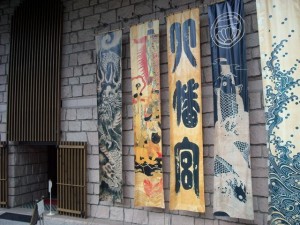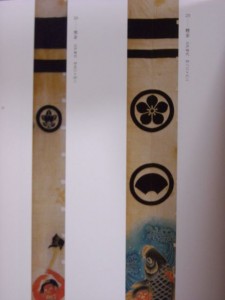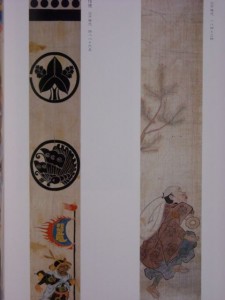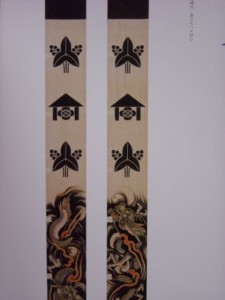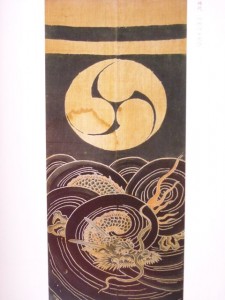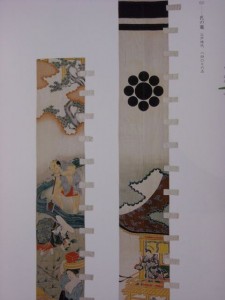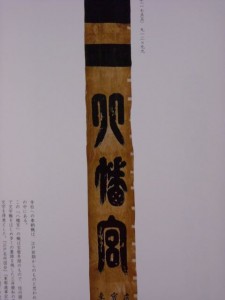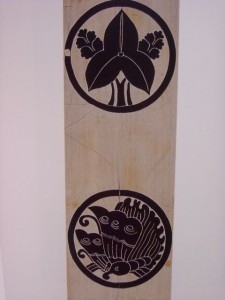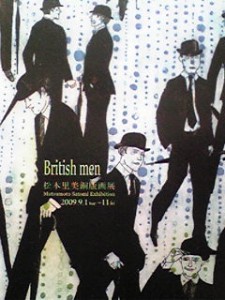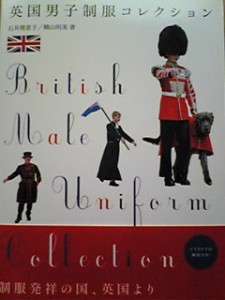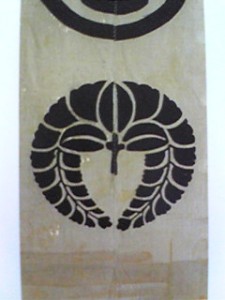
<私の実家の家紋です>
<This is my family crest. “Sagarifuji”>
自分の家の家紋を知ってますか?
私は今まで知りませんでした。今まで意識もせずに
すごしてきました。
今月、家紋の格好よさに気付かされる展覧会を
みました。
松濤美術館で開催されていた「江戸の幟旗」という
展覧会です。(*既に終了しています)
Every Japanese people has the family crests.
But recently, we are not care about that.
I was one of them.
I saw one exhibition which made me realize that
the family crests are cool.
That was the exhibition called
“Edo no nobori-bata “.
I will quote “the introduction” from picture record.
Hand-printed or tsutsugaki-dyed banners with
various colorful designs are called nobori-bata
(painted banners). During the Warring States
period, simple banners with family crests were
used on battlefields, but after the Edo period,
they became ore decorative in nature; banners
with designs of popular historical and legendary
heroes (called mushua-nobori, or “warrior banners”)
were put up on Children’s Day.
For this exhibition, painted banners made from
the Edo to Meiji periods are selected from
the collections of the three most famous collectors.
江戸時代の美術作品に最近みせられている事もあり、
あまり予備知識もないままに一歩会場に足を踏み入れ
ました。天上の高い展示室の壁一面に幅60センチ程
高さ7〜8メートルに及ぶ幟旗が整然と並んでいました。
<7〜8メートルの旗がたくさんならんでおりました>
ここで「幟旗」(のぼりばた)とは。
一番分かりやすいのが、戦国時代武将達が家紋や文字
をつけた旗を背中にさして戦っていましたあれです。
竹竿に一反木綿のごとく長い生地を下げる旗を幟(のぼり)
と言ったそうです。現代では大相撲や歌舞伎の興行などで
よく見かけます。
今回松濤美術館で展示されていたのはそういったイメージ
のものとはまた違う、江戸時代端午の節句に飾られた、
あるいは神社に奉納された文字書きの幟旗でした。
細長い幟旗の殆ど全ての上部には二本線が引かれています。
端午の節句に贈られたまたは飾られた旗は、
その下に当家と送り主の家紋が並び、さらにその下には
絵師が直接描いた龍であったり登り鯉であったり、泡立つ波
であったり、浮世絵師にによって描かれたと思われる
縦長の画面いっぱいを見事な構図でカラフルに描いた説話の
場面があったり、またはシンプルな市松文様のみの旗も
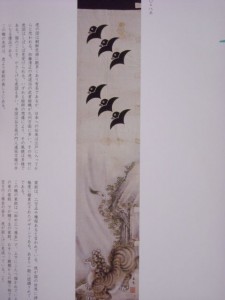
<親戚同士の贈物だと同じ家紋が並びます
鳥の家紋を虎が見上げるように描かれたすばらしい構図の旗>
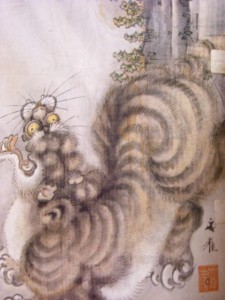
<下の虎をクローズアップするとこんなに美しく描かれています>
あったり。あるものは藍色のみでシンプルにあるものは絵巻
さながらの色使いにとバリエーションと色彩も豊かです。
神社に奉納された旗の文字は手書きで描かれたとは思えない
ほど美しいフォルムをしていて魅力的でした。
どの旗もそのすばらしいデザインが圧巻で、
もれなく全てがまさにセンスよく、格好よく、
そのクールさにすっかり心を奪われました。
そして「家紋」です。家紋がその中におかれている重要さ。
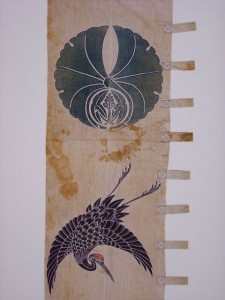
<家紋と絵のコラボレーション>
家紋が画面に置かれてるのと置かれてないのでは締まりがぐっと
変わります。今回はじめてその美しさに気がつきました。
家紋は完璧に極められた究極のデザインマークでした。
旗の中で上部の二本線と下部の絵との間に配したことによって
家紋の美しさもまた完全に生きてくるのでした。
江戸のデザイン力に敬服する展覧会でした。
自分のルーツである家紋がいったい何であるのか知りたく
なったので、父に聞いてみました。「下がり藤」だそうです。
今回の展覧会の中にも同じ家紋を見つけました。
それが一番上にアップした画像です。なかなか良い感じの家紋です。
父曰く「藤原家の系統かな」だそうで、血を引いてる事は全くないと
思いますが、そう聞くとなんだか藤原家に急に親近感が湧いて来たり
するから不思議です(笑)
さらに面白いサイトも見つけました。
ここで名字を入れると自分の家紋がわかるそうです。
でも・・選択肢が結構多くて、やはり家族にきかないと
どれが自分の家紋かはわからないですね。(笑)
http://www.asgy.co.jp/
ルイ・ヴィトンのベーシックな文様も日本の家紋から起草
されたものだと以前聞いた事があります。
もっともっとこの家紋、現代のモノのデザインの中に素敵に
取り入れて残してゆきたいですよね。忘れて行ってしまうなんて
もったいなさすぎます。
展覧会場で残念だったのは会場が撮影禁止だったため、
整然と並ぶ幟旗を撮影できなかったこと。
なにせ細長ーいデザインゆえ、図録からの無理矢理写真
ピックアップでは本物の魅力は全く伝わらない
かと思われます・・
知人のアートブロガーであるTakさんのご自身のアートブログ
「弐代目・青い日記帳」
http://bluediary2.jugem.jp/
にて掲載した記事をリンクさせていただきました。
http://bluediary2.jugem.jp/?eid=1836
記事も詳しく写真もきれいなので、これでより展覧会場の
雰囲気をお分かりいただけるかと・・・。
(Takさんありがとうございます)
今月はアクリル画ばっかり描いていました。
気がつけば工房に一度も行かなかった・・・。そして涼しい
夏ももやもやと終わってしまいました。
来月から銅版画復帰予定です。
あぁ久しぶりにがすっと版画したいです。
そして今日は誕生日。元旦でもないけれど、
迷う事なく進んで行きたい・・っと誓ってみたりして。
Banners were used as signs, and were made by
attaching narrow, rectangular pieces of either
fabric or paper to long poles. To stop them from
fluttering in the wind, the entire length of the left
side (usually) was secured to the pole. The poles
used windly for raising banners are especially called
noborizao, and the horizontal bar attached to the
top of part is called Kanzashi. Sometimes small
streamers called maneki might be attached to
the end of the noborizao or kanzashi.
Although about 80% of the banners we see today
are made of cotton, paper and hemp were popular
materials until the mid-Edo period due to the fact
that cotton was very expensive (smaller banners
displayed within the home might be made of silk).
Banners were hand-painted or dyed using the
tsutsugaki technique. Dye material, including indigo
and other natural pigments such as gofun (whitewash),
vermillion, ultramarine and dull green were effectively
used.
The origin of banners is not clear, but under the 11th
year of Empress Suiko (603) in the Nihonshoki,
mention of the religious use of hata (one form of
painted banner ) can be bound. It is said that in the
ancient days, banners were used to mark the sacred
places where kami(gods) were thought to come down
or dwell. These hata were also used on battlefields,
their standard form settling into a long and narrow
rectangular shape. Ornamental banners used in more
peaceful times also take this shape. As society became
peaceful, during the Edo period (1603-1868) the
practice of raising banners became more ceremonial;
even today, people in Japan celebrate May fifth
Tango no sekk, or Children’s Day, by displaying
warrior dolls and weapons, ritual offerings, and
painted banners and carp streamers. Legendary
heroes, famous warriors, historical personalities,
strong and wise gods are painted on these banners.
Moreover banners of a more commercial nature
called kandan nobori, or “sign” banners are used
for theaters, shops and sumo tournaments,
especially after the Edo period.

